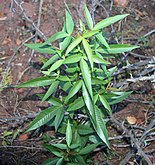
Curtisia dentata is a flowering tree from Southern Africa. It is the sole species in genus Curtisia, which was originally classed as a type of "dogwood" (Cornaceae), but is now placed in its own unique family Curtisiaceae.

The rowans or mountain-ashes are shrubs or trees in the genus Sorbus of the rose family, Rosaceae. They are native throughout the cool temperate regions of the Northern Hemisphere, with the highest species diversity in the Himalaya, southern Tibet and parts of western China, where numerous apomictic microspecies occur. The name rowan was originally applied to the species Sorbus aucuparia and is also used for other species in Sorbus subgenus Sorbus.
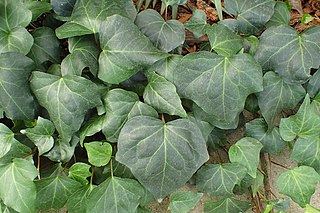
Hedera, commonly called ivy, is a genus of 12–15 species of evergreen climbing or ground-creeping woody plants in the family Araliaceae, native to Western Europe, Central Europe, Southern Europe, Macaronesia, northwestern Africa and across central-southern Asia east to Japan and Taiwan.
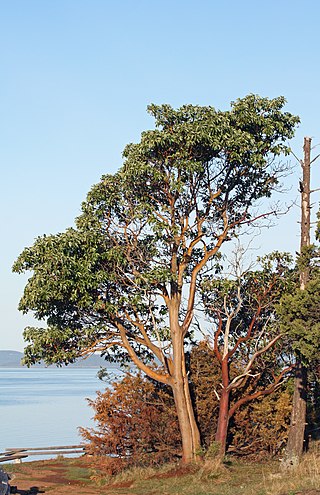
Arbutus menziesii or Pacific madrone, is a species of broadleaf evergreen tree in the family Ericaceae, native to the western coastal areas of North America, from British Columbia to California. It is nicknamed the "Refrigerator Tree" due to the fact that its bark contains water, and it stays cool in the summer

Amelanchier alnifolia, the saskatoon berry, Pacific serviceberry, western serviceberry, western shadbush, or western juneberry, is a shrub with an edible berry-like fruit, native to North America.

Rubus parviflorus, commonly called thimbleberry, is a species of Rubus native to northern temperate regions of North America. The plant has large hairy leaves and no thorns. It bears edible red fruit similar in appearance to a raspberry, but shorter, almost hemispherical. It has not been commercially developed for the retail berry market, but is cultivated for landscapes.

Ilex aquifolium, the holly, common holly, English holly, European holly, or occasionally Christmas holly, is a species of flowering plant in the family Aquifoliaceae, native to western and southern Europe, northwest Africa, and southwest Asia. It is regarded as the type species of the genus Ilex, which by association is also called "holly". It is an evergreen tree or shrub found, for example, in shady areas of forests of oak and in beech hedges. In the British Isles it is one of very few native hardwood evergreen trees. It has a great capacity to adapt to different conditions and is a pioneer species that repopulates the margins of forests or clearcuts.
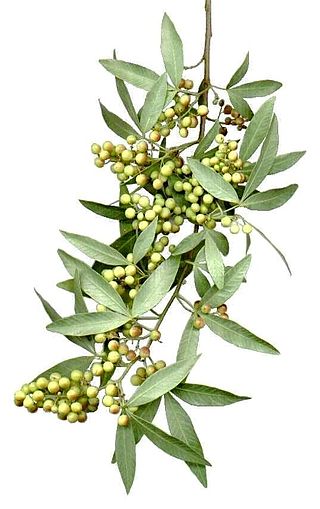
Searsia pendulina, commonly known as the white karee (English) or witkaree (Afrikaans), is a hardy, very fast growing, semi-deciduous tree. It occurs naturally along the Orange River and some of its tributaries.

Searsia pyroides, previously known as Rhus pyroides, is a species of Searsia, native to southern Africa. This tree occurs throughout the whole of South Africa, a part of Botswana, Zimbabwe and Tanzania and in some areas of Namibia near Windhoek.

Searsia lucida, previously known as Rhus lucida, and commonly known as the varnished kuni-rhus (English) or blinktaaibos (Afrikaans).
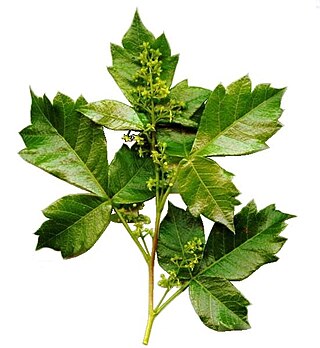
Searsia dentata, the nana-berry (English), or nanabessie (Afrikaans), is a medium-sized, deciduous tree, reaching a height of about 5 metres and a spread of 4 metres, and with a tendency to scramble through and over neighbouring trees. It occurs naturally in almost the whole of South Africa except the Western and Northern Cape Provinces. Its habitat varies from sea level to the highlands of the Drakensberg. It is frost-hardy and should be planted in full sun. The strongly aromatic leaves are usually conspicuously toothed, though sometimes they may be only slightly toothed. The tree produces small, creamy-white flowers in masses, developing into small, flattened drupes (5-6mm) which turn red or orange when ripe and brown when dry. The ripe fruits are eaten by birds, while the foliage is food for the larvae of the pepper tree moth Bombycomorpha bifascia.
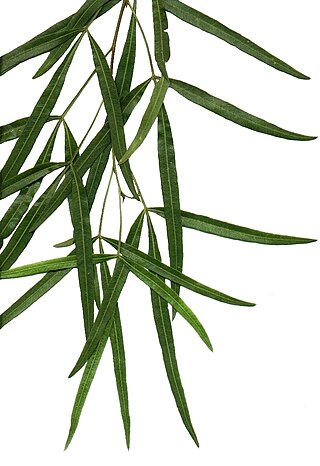
Searsia lancea commonly known as karee, is an evergreen, frost hardy, drought resistant tree, which can reach up to 8 metres in height with a 5-metre spread. It is one of the most common trees on the Highveld and in the Bushveld in South Africa, but not found in the Lowveld. In North America, where it is naturalized, it is known as African sumac and willow rhus.
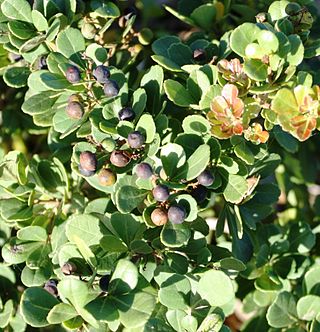
Searsia crenata, previously known as Rhus crenata,, is a species of Searsia that is native to South Africa, where it grows in frost-free and light frost areas, especially on beach sand dunes.
Searsia pentheri, the common crowberry (English), gewone kraaibessie (Afrikaans), iNhlokoshiyane (Zulu), or mutasiri (Venda), is a species of tree in the genus Searsia. Frost hardy tree reaching a height of up to 6 metres. The tree is mainly evergreen but loses its leaves in severe winters. It has olive-green foliage with dark brown bark and can be grown in either full sun or semi shade. Small flowers are produced and are followed by masses of shiny, light brown, small edible fruits, which provide a feast for birds. Only female trees produce these fruits though. The tree occurs over large portions of South Africa. It has been planted in Spain.
Searsia gerrardii, the Drakensberg karee, is a deciduous, drought resistant tree, native to South Africa. It reaches a height of up to 5 metres. It is frost hardy and occurs naturally in mountain areas, often along riverbanks. The tree has a graceful drooping habit. It produces small yellowish flowers which, on female trees, turn into small fruits which are relished by birds. This tree makes a lovely shade tree for a small garden.
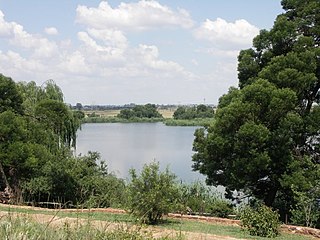
Rietvlei Nature Reserve, located in southern Pretoria, is about 4,000 hectares (40 km2) in size, and includes the entirety of the Rietvlei Dam which impounds the Rietvlei River, in Gauteng, South Africa. The reserve is wedged between the R21 highway on the western side and the R50 (Delmas-Bapsfontein) road on the north-east. The mean elevation above sea level is approximately 1,525 meters, with the highest point at 1,542 m and the lowest at 1,473 m, the dam’s outflow in Sesmylspruit. The reserve covers a surface area of approximately 4,003 ha or 40 km2, of which the dam constitutes some 20ha. A network of roads criss-cross the entire area, which facilitates access to visitors and management.

Renosterveld is a term used for one of the major plant communities and vegetation types of the Cape Floristic Region which is located in southwestern and southeastern South Africa, in southernmost Africa. It is an ecoregion of the Mediterranean forests, woodlands, and scrub biome.

Cassine peragua, also known as Cape saffron, bastard saffron and forest spoonwood, is a medium-sized tree with fragrant flowers, decorative fruits and a saffron-coloured trunk. It is indigenous to the Afro-montane forests of South Africa.

Searsia angustifolia, the willow karee or smalblaar, is a small, bushy, evergreen tree which is confined to the South Western Cape in South Africa.
Bird food plants are certain trees, shrubs and herbaceous plants bearing fruits which afford food for birds. These have been discovered by observation, and by the scientific examination of the contents of birds' stomachs. By planting those species, therefore, which have been proved most desirable and that are suited to the climate and soil of the chosen location, birds can be attracted to the vicinity of dwelling houses or to any other desired spot as a copse or shrubbery, or, on the other hand, lured away from valuable orchards, since they appear to like best arid, bitter, sour or aromatic fruits, distasteful to human beings, even better than the cultivated kinds.

